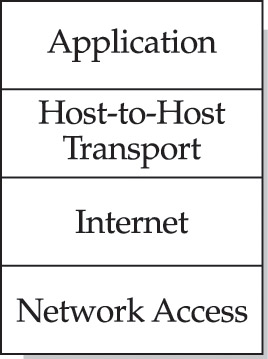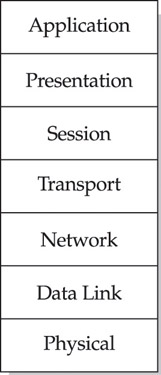Architectural Models for Communications Protocols
|
|
Architectural Models for Communications Protocols
To provide for an environment in which communication protocols can be developed to work with each other, a framework is used to help explain and develop the protocols. This architectural model provides a common frame of reference and separates the functions performed by communication protocols into four layers stacked vertically: the application layer, host-to-host transport layer, Internet layer, and network access layer. Each layer in the stack performs a specific function. Any number of protocols can be written and used for that function.
Because each layer has a specific function, it can perform that function without worrying about what's happening at all the other layers. Because each layer passes data to the layer above or below it in a defined method and then forgets about the data, only its peer layer at the other end of the communication is of consequence.
Two architectural models are commonly used to describe TCP/IP communication: the DoD protocol model and the Open Systems Interconnection (OSI) protocol model.
The DoD Protocol Model
Originally, the DoD protocol model, or Internet reference model, had three layers: network access, host-to-host transport, and application. Later, a fourth layer, Internet, was added. This model is commonly used to describe how TCP/IP works. The DoD model is shown in Figure 8-1.

Figure 8-1: DoD protocol/Internet reference model
Each of the four layers of the DoD model has a specific function:
-
Application layer The top layer in the model includes the protocols that process user data and manage data exchange between applications. This layer also standardizes the presentation of data.
-
Host-to-host transport layer The next layer contains the protocols used for providing end-to-end data integrity. It also provides the controls that initiate and terminate communications.
-
Internet layer This layer contains the protocols used for routing messages through the network. This layer puts data into a datagram.
-
Network access layer The lowest layer in the model contains the protocols used to deliver the data physically to devices on the network. This layer puts data into a frame.
The OSI Protocol Model
The Open Systems Interconnection (OSI) protocol model is a seven-layer model developed by the International Organization for Standardization (ISO-the same group that developed the ISO9000 standards) that corresponds to the layers in the DoD model. The OSI model was originally set up to be the universal standard for all communication protocols, but support waned for the standard. Now protocols usually loosely correspond to the OSI model, but they don't necessarily follow it exactly. The OSI model layers are shown in Figure 8-2.

Figure 8-2: The OSI protocol model
Each of the seven layers of the OSI model has its own specific functions:
-
Application layer This top layer supports application and end-user processes. Everything at this layer is application specific. This layer provides application services for file transfers, e-mail, and other network software services.
-
Presentation layer This layer provides independence from differences in data representation. It transforms data into a usable form for the application layer.
-
Session layer This layer is not concerned with the network connection. At this level, the connection is assumed. The layer contains the control structure for managing connections between applications.
-
Transport layer This layer is responsible for complete transfer of data between hosts. It provides for error detection and recovery, and it ensures error-free transmission of data. The TCP and UDP protocols fall in this layer.
-
Network layer This layer is responsible for addressing and creating virtual circuits to transfer data from end to end. IP addresses fall in this layer.
-
Data link layer This layer is divided into two sublayers: The Logical Link Control (LLC) layer controls frame synchronization and flow control, and the Media Access Control (MAC) layer controls the addressing for the data link layer.
-
Physical layer This layer defines the specifications for the physical components of network communication. Bits, signaling, and cable specifications are all at this layer. This layer works with the 0's and 1's of communication.
|
|
EAN: 2147483647
Pages: 193